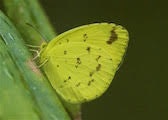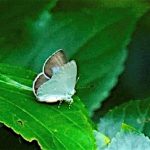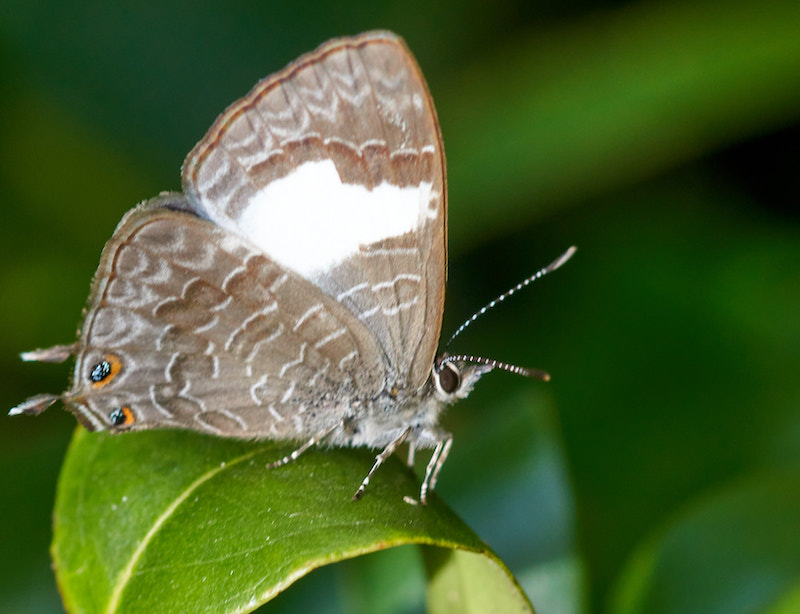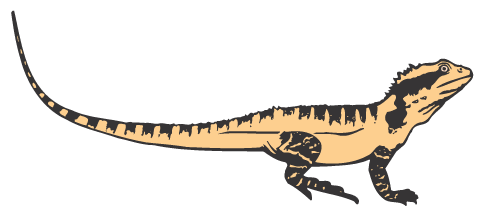BUTTERFLY SPECIES COMMONLY FOUND IN THE MOGGILL CREEK CATCHMENT
The photos in this list were taken in the catchment and are the copyright of either Ed Frazer and Dale Borgelt, as shown. The list has 4 categories:
1. Swallowtails
| 1. SWALLOWTAILS (Papilionindae) | ||||
| Species | Common name and size Scientific name Other names |
Similar species also found in the catchment |
Host plants (caterpillar) | Notes and recommended plantings |
 © Ed Frazer © Ed Frazer |
Blue Triangle (m) 60mm Graphium sarpedon |
See Pale Triangle | Litsea reticulata Cryptocarya spp Clerodendron spp Cinnamomum camphora Beilschmiedia elliptica B. obtusifolia Geijera salicifolia Neolitsea dealbata |
Plant native laurels:
These may help disperse pheromones to the female. |
 © Dale Borgelt © Dale Borgelt |
Blue Triangle (f) 60mm Graphium sarpedon |
|||
 © Ed Frazer © Ed Frazer |
Chequered Swallowtail (m) 75mm Papilio demoleus |
None | Cullen tenax Occasionally Citrus australasica |
Plant Emu foot (Cullen tenax) in full sun Found along creeks in drier areas |
 © Ed Frazer © Ed Frazer |
Chequered Swallowtail (f) 75mm Papilio demoleus |
|||
 Male © Ed Frazer |
Clearwing Swallowtail (m) 80mm Cressida cressida Greasy Swallowtail Big Greasy |
See Dainty Swallowtail See Glasswing |
Aristolochia meridionalis Pararistolochia praevenosa |
Plant Birdwing Butterfly Vine (Pararistolochia praevenosa) Males fly slowly over breeding areas looking for femalesThe females fly close to the ground and come to rest frequentlyCommon butterfly |
 Female © Ed Frazer |
Clearwing Swallowtail (f) 70mm Cressida cressida Greasy Swallowtail Big Greasy |
|||
 © Dale Borgelt © Dale Borgelt  © Ed Frazer |
Dainty Swallowtail (m & f) 70mm Papilio inactus Dingy Swallowtail Small Citrus Butterfly |
See Clearwing Swallowtail above | Citrus australis Geijera parviflora |
Plant Australian Round Lime (Citrus australis) |
 © Dale Borgelt © Dale Borgelt |
Four-barred Swordtail (m) 53mm Protographium leosthenes |
None | Melodorum leichhardtii | Plant Zig Zag Vine (Melodorum leichhardtii )
Can also be grown as a flowering and fruiting shrub Female lighter brown, similar pattern |
 © Ed Frazer © Ed Frazer |
Fuscous Swallowtail (m) 85mm Papilio fuscus Tailed Citrus Butterfly |
See Orchard Swallowtail below | Micromelum minutuum M. ovatifoliolata Zanthoxylum brachyacanthum |
Plant Lime Berry (Micromelum minutum ) Common after a wet season. Fly slowly and found often near citrus trees |
 © Dale Borgelt © Dale Borgelt  © Ed Frazer |
Orchard Swallowtail (m) 102mm Papilio aegus Orchard Butterfly |
See Fuscous Swallowtail above | Citrus australis C.australasica Flindersia bennettiana F. australis F. collina Geijera salicifolia Melicope micrococca Zanthoxylum smithii Z. brachyacanthum |
Recommended plants:
Common Often seen in gardens with Citrus trees |
  © Ed Frazer |
Orchard Swallowtail (f) 110mm | See Clearwing Swallowtail See Dainty Swallowtail |
Female in photo is laying eggs on an Orange tree | |
 © Dale Borgelt © Dale Borgelt  © Ed Frazer |
Pale Triangle (m) 59mm Graphium euryplus Pale Blue Triangle Pale Green Triangle |
See Blue Triangle | Melodorum leichhardtii Polyalthia nitidissima Annona reticulata |
Recommended plants:
Newly emerged can be so blue that they can be mistaken for Blue Triangles Their colour fades after just a few days, (shown in the second photo) |
| 2. WHITES AND YELLOWS (Pierinae) | ||||
| Species | Common Name and size Scientific name Other names |
Similar species also found in the catchment |
Host plants (caterpillar) | Notes and recommended plantings |
|
  Females   Males © Ed Frazer
|
Black Jezebel (m & f) 56mm Common Jezebel Delias negrina |
See Jezebel Nymph (Mynes geoffroyi) in the Nymphs section |
Several mistletoes | Not common in the catchment. Migrates up from NSW in the Autumn and often flies with the more common Scarlet Jezebel. Appears black when flying, in contrast with the Scarlet Jezebel, which looks white when flying |
 © Ed Frazer |
Cabbage White (m & f) 44mm Pieris rapae |
See Pearl Whites | Brassicas | Pest species introduced |
 © Ed Frazer |
Caper Gull (m & f) 43mm Cepora perimale Australian Gull Northern Gull |
See Yellow Albatross female See Caper White below |
Capparis arborea C. velutina |
Recommended plants:
|
 Male © Ed Frazer
|
Caper White (m) 55mm Belenois java |
See Jezebels | Capparis arborea | Plant Caper Bush (Capparis arborea) The strong yellow colour shown in the female photo fades quickly after hatching |
 Female © Ed Frazer Female © Ed Frazer |
Caper White (f) 55mm Belenois java |
|||
 © Ed Frazer |
Large Grass-yellow (m & f) 37mm Eurema hecabe Common Grass-yellow |
See Small Grass-yellow | Acacia irrorata A. maidenii A. melanoxylon Breynia oblongifolia Senna acclinis Sesbania cannabina |
Plant Wattle (Acacia spp) |
 © Ed Frazer |
Lemon Migrant (m) 58mm Catopsilla pomona Cassia Butterfly |
White Migrant See Yellow Migrant |
Cassia spp Senna spp |
Breed only in the wet season
Very large migrations take place during warmer months Present and common most of the year in the catchment |
 © Ed Frazer © Ed Frazer |
Lemon Migrant (f) 58mm Catopsilla pomona Cassia Butterfly |
|||
 © Ed Frazer |
No-brand Grass-yellow 36mm Eurema brigitta |
See Small Grass-yellow | Chamaecrista nomame | One of the three common Grass-Yellows in the Catchment Common in pasture areas |
 © Ed Frazer  © Ed Frazer © Ed Frazer |
Scarlet Jezebel Delias argenthona Northern Jezebel |
Spotted Jezebel See Jezebel Nymph (Mynes geoffroyi) in the Nymphs section |
Several Mistletoe species | Retain trees with Mistletoe
Display red and yellow colours when wings folded Underside is black and white |
 © Ed Frazer |
Small Grass-yellow (m & f) 33mm Eurima smilax |
See Large Grass-yellow | Cassia spp Senna spp |
Grass-yellows are easily recognised by their size and colour but individual species are difficult to identify in the field |
 © Ed Frazer |
Southern Pearl-white (m) 38mm Elodina angulipennis Common Pearl-white |
Narrow-winged Pearl-white | Capparis arborea C. velutina |
Plant Caper Bush (Capparis arborea) |
 © Ed Frazer |
Southern Pearl-white (f) 38mm Elodina angulipennis Common Pearl-white |
|||
 © Ed Frazer |
Yellow Albatross (m) 53mm Appias paulina Common Albatross |
See Cabbage White | Drypetes deplanchei | Plant Yellow Tulip (Drypetes deplanchei) |
 © Ed Frazer |
Yellow Albatross (f) 53mm Appias paulina Common Albatross |
See Caper Gull | Female is very similar to the Caper Gull | |
 © Dale Borgelt |
Yellow Migrant (m & f) 56mm Catopsilia gorgophone |
See Lemon Migrant | Senna spp | Yellow Migrant has white upper forewing This species has re-established in the Catchment in recent years, especially in the Gap Creek Road area |
| 3. NYMPHS (Nymphalidae) | ||||
| Species | Common name and size Scientific name Other names |
Similar species also found in the catchment |
Host plants (caterpillar) | Notes and recommended plantings |
 © Ed Frazer © Ed Frazer  © Ed Frazer © Ed Frazer |
Australian Painted Lady (m & f) 43mm Vanessa kershawi |
None | Chrysocephalum apiculatum Helichrysum apicualtum |
Plant everlasting Yellow Buttons (Chrysocephalum apiculatum) Very common |
 © Ed Frazer © Ed Frazer |
Blue Tiger (m & f) 72mm Tirumala hamata |
None | Secamone elliptica |
Plant Cork Vine (Secamone elliptica)
Large migrations of the species occur in some years In other years is it not common in the Catchment |
 © Ed Frazer © Dale Borgelt |
Border Rustic (m & f) 53mm Cupha prospe |
None | Scolopia braunii | Not a common species in the Catchment but has made a comeback with the planting of the Flintwood Tree (Scolopia braunii) on several properties |
 © Ed Frazer |
Brown Ringlet (m & f) 31mm Hypocysta metirius Common Ringlet |
See Grey Ringlet See Orange-streaked Ringlet |
Cynodon dactylon Oplismenus hirtellus Ottochloa gracillima |
Green Couch (Cynodon dactylon) is widespread in the catchment so no planting is needed |
  © Ed Frazer |
Common Crow (m & f) 72mm Euploea core Oleander Butterfly |
See Crow Moth See White-banded Plane |
Carrisa ovata Ficus rubiginosa Ficus virens Marsdenia fraseri Parsonsia brisbanensis P. straminea Secamone elliptica |
Recommended plants:
|
 © Dale Borgelt  © Ed Frazer
|
Evening Brown (m & f) 63mm Melanitis leda |
See Leafwing | Themeda triandra | Plant Sedges (Carex spp) in damp areas
Some C. appressa varieties are suitable in drier areas Kangaroo Grass (Themeda triandra) is a perennial tussock and can be grown from seed The Evening Brown lies in the leaf litter during daytime and is well camouflaged If disturbed it flies a short distance and then settles |
 © Ed Frazer |
Glasswing (m & f) 56mm Acraea andromacha Little Greasy Small Greasy |
See Clearwing Swallowtail | Passiflora aurantia P. herbertiana Afrohybanthus stellarioides |
Fly continuously just above the ground Caterpillars feed on exotic passionfruit |
 © Ed Frazer |
Grey Ringlet (m & f) 31mm Hypocysta pseudirius Dingy Ringlet |
See Brown Ringlet | Themeda triandra | Lays eggs on Kangaroo Grass (Themeda triandra) |
  © Dale Borgelt |
Jezebel Nymph (m & f) 57mm Mynes geoffroyi guerini White Nymph |
Black and Red-banded Jezebels | Dendrocnide photinophylla Pipturus argenteus |
Plant Native Mulberry (Pipturus argenteus) Often found along streams |
 © Dale Borgelt |
Leafwing (m & f) 65mm Doleschallia bisaltide Australian Leafwing |
See Evening Brown | Brunoniella spp Pseuderanthemum variabile |
Plant Love Flower (Pseuderanthemum variabile), a ground cover from the African Violet family |
|
 © Ed Frazer |
Lesser Wanderer (m & f) 60mm Danaus chrysippus petilia |
See Monarch Daniad Eggfly |
Tylophora grandiflora Gomphocarpus physocarpus |
Thrives on the exotic Swan Plant (Gomphocarpus physocarpus) and introduced milkweeds |
  © Ed Frazer |
Meadow Argus (m & f) 43mm Junonia villida calybe |
None | Goodenia rotundifolia Plantago spp Verbena spp |
Does well on a number of introduced garden plants and weeds so no need for further planting of host plants |
 © Ed Frazer © Ed Frazer |
Monarch (m & f) 93mm Danaus plexippus Wanderer Butterfly Milkweed Butterfly |
See Lesser Wanderer | Gomphocarpus fruticosus Gomphocarpus physocarpus Asclepias curassavica |
Breeds on Swan Plant (Gomphocarpus physocarpus) and Milkweeds introduced into Australia |
 © Ed Frazer |
Orange-streaked Ringlet 35mm Hypocysta irius Northern Ringlet |
See Orange Ringlet below | Grasses | Found in grassed areas adjacent to forest Has larger eyespots than other Ringlets |
 © Ed Frazer © Ed Frazer |
Orange Ringlet (m & f) 30mm Hypocysta adiante Dusky-bordered Ringlet |
See Orange-streaked Ringlet above | Themeda triandra | Plant Kangaroo Grass (Themeda triandra) and other grasses |
  © Ed Frazer © Ed Frazer |
Purple Crow (m & f) 60mm Euploea tulliolus Eastern Brown Crow |
None | Trophus scandens subsp scandens | Plant Burny Vine (Trophus scandens), a large woody climber from the fig family with red edible fruit |
  © Ed Frazer |
Tailed Emperor (m & f) 85mm Polyura sempronius Four-tail |
None | Mostly Mimosaceae and Caesalpiniaceae Brachychiton Celtis spp. |
Caterpillars feed on a wide range of plants but favour Wattles, Cassias and Sennas
Very large butterfly that looks more like a Swallowtail than a Nymph Widespread but not common |
 Gender indeterminate © Ed Frazer  Male © Ed Frazer |
Varied Eggfly (m) 76mm Hypolimnas bolina Common Eggfly |
Daniad Eggfly (m) outerside view | Alternanthera denticulata Pseuderanthemum variabile Sida spp Hygrophila angustifolia |
Plenty of host food in the area so no need for plantings
Male smaller and differs substantially from female Males establish territories on edge of bush close to larval food plants |
 Female © Ed Frazer |
Varied Eggfly (f) 86mm Hypolimnas bolina Common Eggfly |
Daniad Eggfly (m) underside view | Females usually found flying near food plants | |
 © Ed Frazer |
White-banded Plane (m & f) 57mm Phaedyma shepherdi Common Aeroplane |
See Common Crow See Crow Moth |
Aphananthe philippinensis Brachychiton acerifolius Celtis paniculata Ehretia acuminata |
Recommended plants:
For a smaller tree use Native Celtis (Celtis paniculata) Distinctive gliding flight |
 © Ed Frazer  © Ed Frazer |
Yellow Admiral (m & f) 50mm Vanessa itea Australian Admiral |
None | Pipturus argenteus Urtica incisa |
Plant Native Mulberry (Pipturus argenteus)
Found around creeks and damp slopes Also frequently found heads down on rocks or trees in forested areas |
| 4. BLUES (Lycaenidae), SKIPPERS (Hesperiidae) and MOTHS | ||||
| Species | Common name and size Scientific name Other names |
Similar species also found in the catchment |
Host plants (caterpillar) | Notes and recommended planting |
| BLUES | ||||
 © Ed Frazer |
Cycad Blue (m & f) 24mm Theclinesthes onycha |
Wattle Blue (Theclinesthes miskini) | Macrozamia spp and exotic Cycads | Feeds on the newly emerged leaves of a wide range of cycadsQuite destructiveLarvae occasionally attended by antsHint: if Cycad Blue caterpillars are destroying fresh shoots on your garden cycads, check the new fronds daily and scrape the eggs off with your fingernail. For more hints about control see Annette McFarland’s gardening website |
 © Ed Frazer |
Common Grass Blue (m & f) 23mm Zizina labradus Common Blue |
Spotted Grass-Blue | Wide range of legumes including garden beans and lucerne |
Larvae occasionally attended by ants |
 © Ed Frazer |
Common Pencilled-Blue (f) 31mm Candalides absimilis Pencil Blue |
Dark Pencil-Blue | Alectryon coriaceus A. subcinerus Atalaya salicifolia Brachychiton acerifolius B. populneus Callerya megasperma Cupaniopsis anacardioides Flagellaria indica Harpullia pendula Macadamia spp |
Caterpillars eat a wide range of plants including:
|
 © Ed Frazer © Ed Frazer |
Indigo Flash Rapala varuna |
None | Alectron tomentosus Alphitonia excelsa Cupaniopsis anacaroides Jagera pseudorhus |
Feeds on flowers and flower buds and a wide range of plants including Foam Bark (Jagera pseudorhus) and Lychees (Litchi chinensis) |
  © Ed Frazer
|
Plumbago Blue 23mm Leptotes plinius Zebra Blue Plumbago Argus |
None | Plumbago zelanica | Garden plumbagos are also host plants |
 © Ed Frazer  © Ed Frazer
|
Small Dusky-blue 22mm Candalides erinus |
See Varied Dusky-blue | Cassytha filiformus | Dodder Laurel (Cassytha filiformis) is a parasitic vine that can smother plants It has small fruit that is eaten by Mistletoebirds |
 © Dale Borgelt |
Small Green-banded Blue (m) 30mm Psychonotis caelius |
None | Alphitonia excelsa | Plant Red Ash (also known as Soap Tree) (Alphitonia excelsa) Found in wet shady areas |
 © Ed Frazer
|
Varied Dusky-blue 28mm Candalides hyacinthina Common Dusky-blue |
See Small Dusky-blue | Cassytha spp. | Dodder Laurel (Cassytha fiiformis), recorded in the MCC, is a hemiparasitic vine and probably the local host of this species |
 © Ed Frazer
|
Purple Moonbeam; Size M 28mm F 30mm; Scientific Name Philiris innotata; Common Moonbeam |
None | Sandpaper fig (Ficus coronata). | Adult butterflies are not easily observed, spending much of their time high in the canopy, but damage on the undersides of the leaves of the sandpaper fig often betrays the presence of the larvae. |
 © Ed Frazer
|
Hairy Line-blue
Erysichton palmyra
22mm (f)
|
Marbled Line-blue |
Habitat Rainforest Edges
Larval Food plants flowers of Macadamia Syzigium
Status common but local
|
|
| SKIPPERS (Hesperiidae) | ||||
  © Ed Frazer |
Dingy Grass-skipper 30mm Taxidia peron Large Dingy-skipper |
Other Grass-skippers | Various grasses | Found in the same long grass areas as the Grass-darts but much larger and less colourful |
 © Ed Frazer |
Narrow-brand Grass-dart (m & f) 15mm |
See Wide-brand Grass-dart | Grasses | Very small species found in open grass areas adjacent to Eucalypt forest |
 © Ed Frazer © Ed Frazer |
Pale Orange Darter 29mm Telicota colon Pale Darter |
Southern Sedge-darter | Panicum Phragmites Sorghum |
Larger than the Grass-darts Upper-side wings lighter |
|
 Male Male
© Ed Frazer |
Splendid Ochre (m) 38mm Trapezites symmomus Symmomus Ochre |
Ochres | Lomandra longifolia | Plant Spiny-headed Mat Rush (Lomandra longifolia) Much larger than most other Skippers |
|
 Female Female
© Ed Frazer |
Splendid Ochre (f) 38mm Trapezites symmomus Symmomus Ochre |
|||
 © Ed Frazer |
Wide-brand Grass-dart (m) 22mm Suniana sunias Orange Dart |
Dark Grass-dart | Megathyrsus maximus | Found in open Eucalypt forest particularly in areas of long uncut grasses |
 © Ed Frazer |
White-banded Grass-dart (m & f) 20mm Taractrocera papyria White Grass-dart |
Large Yellow Grass-dart No-brand Grass-dart |
Carex polyantha Cynodon dactylon Imperata cylindrica Microlaena stipoides Poa labillardieri |
Found in areas of Bladey Grass, Couch, Tussock Grass and Sedges |
| MOTHS (Butterfly mimics and day-flying species) | ||||
 © Ed Frazer |
Anthela sp. 70cm | Several similar species | Unknown | Night flying
Adult does not feed Caterpillar is hairy |
 © Ed Frazer © Ed Frazer |
Arch Moth (m & f) 60mm Bracca matutinata |
Not known | Has a resemblance to the endangered Laced Fritillary Butterfly, which also has many black spots.
Caterpillars are very colourful. Night flying but found during the day in dull weather in rainforest |
|
 © Ed Frazer |
Crow Moth (m & f) 45mm Cruria donowani |
See Common Crow Butterfly | Hibbertia obtusifolia | Black, brown and green caterpillar feeds on Guinea Flower (Hibbertia obtusifolia)
Mimics the Crow Butterfly Day flyer |
 © Ed Frazer |
Heliotrope Moth (m & f) 40mm Utetheisa pulchelloides Salt and Pepper Moth |
None | Echium plantagineum Heliotropium eurpaeum |
Feeds on Patterson’s Curse (E. plantagineum), Heliotrope and several other Boraginaceae plants from which it obtains poisons Day and night flying moth which looks like a butterfly when in flight Migrates extensively, even to New Zealand |
 © Ed Frazer  © Ed Frazer
|
Joseph’s Coat Moth (f) 70mm Agarista agricola Painted Vine Moth |
None | Clematicissus opaca Cayratia clematidea |
Caterpillars are black and white with two yellow bands |
 © Ed Frazer |
Magpie Moth Nyctemera sp. |
Several similar species | Crassocephalum crepidiodes | Black-banded caterpillar feeds on Fireweed (C. crepidiodes)
Wasp mimic Day flyer |
 © Ed Frazer |
Magpie Moth Nyctemera secundiana |
Crassocephalum crepidiodes | Larvae feed on Fireweed (C. crepidiodes) Day flyer | |
 © Ed Frazer |
Orange-Spotted Tiger Moth 30mm Ceryx guttulosa |
None | Lichens | Mimics wasps
Found in Eucalypt woodlands and gardens Caterpillars covered in dense black hairs Day flyer |
 © Ed Frazer |
Rectangular-striped Noctuid Moth Grammodes justa |
Unknown | Found in daylight in grassy areas | |
 © Ed Frazer |
White-banded Noctuid Moth (m & f) 70mm |
None | Unknown | Adult moths attracted to rotten fruit
Common Night flyer |
 © Ed Frazer |
Yellow-spotted Tiger Moth 60mm Agape chloropyga |
None | Ficus spp. | Grey caterpillar with fine hairs |




